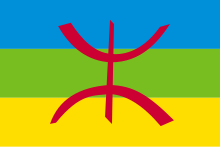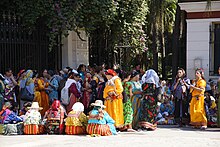Kabyle
The Kabyle (own name kabylisch iqbayliyen , also izouaouen ; Tifinagh script : ⵍⵇⴱⴰⵢⵍ Leqbayel , Arabic القبائل, DMG al-qabā'il , the strains') are in the Northeast in Algeria located Kabylei living subgroup of Berber . Their language is Kabyle . The ethnic group has around 5.5 million members, almost half of whom have moved to other regions of Algeria or emigrated abroad, mainly to France .
religion
The Kabyle are predominantly Sunni Muslims. The two strongest parties in the region, which together get 80% of the vote, are emphatically secular .
ethnography
In the 1960s, the sociologist Pierre Bourdieu dealt with gender relations in ethnographic studies on Kabylia. In this social structure, he emphasized the contrast between male and female as the most important classification principle. Women are associated with certain negative, men with positive traits. The woman is constructed as a "negative entity defined solely by deficiency". Masculinity is associated with acts of war, with turning away from the maternal and feeble, and with strength and protection through cracking down on lawbreakers who threaten the unity of the clan. For the Kabyle woman, on the other hand, the “low, crooked, small, petty, unimportant thing is determined”, whereby she is condemned to “give the semblance of a natural origin to the degraded identity that is socially assigned to them”. Thus the man represents the public, official, external sphere and claims for himself the spectacular and dangerous activities. The woman, on the other hand, remains limited to the domestic, private sphere and does the invisible, lower work.
Famous Kabyle are Zinédine Zidane and Abd el Kader .
Individual evidence
- ↑ Le Kabyle Algérie. Center de Recherche Berbere, 2011
- ↑ Pierre Bourdieu : Draft of a theory of practice. On the ethnological basis of Kabyle society . Suhrkamp, Frankfurt am Main 1976, ISBN 3-518-27891-6 (French 1972)
- ↑ Bridget Fowler: Pierre Bourdieus Reading the male rule. Notes on an intersectional analysis of gender, culture and class. In: Ulla Bock , Irene Dölling, Beate Krais (eds.): Precarious Transformations. Pierre Bourdieus Sociology in Practice and its Challenges for Women and Gender Studies. Wallstein, Göttingen 2007, p. 141.
- ↑ Pierre Bourdieu: The male rule. Suhrkamp, Frankfurt a. M. 2005, p. 51.
- ^ Fowler, Bridget (2007): Pierre Bourdieus Reading the male rule. Notes on an intersectional analysis of gender, culture and class. In: Ulla Bock, Irene Dölling, Beate Krais (eds.): Precarious Transformations. Pierre Bourdieus Sociology in Practice and its Challenges for Women and Gender Studies. Göttingen: Wallstein Verlag. P. 146
- ↑ Bourdieu, Pierre (2005): The male rule. Frankfurt a. M .: Suhrkamp. P. 51
- ↑ Bourdieu, Pierre (2005): The male rule. Frankfurt a. M .: Suhrkamp. P. 58
- ↑ Bourdieu, Pierre (1997): The male rule . In: Irene Dölling, Beate Krais (ed.): A daily game. Gender construction in social practice. Frankfurt a. M .: Suhrkamp. P. 162.

